© 2023 Dr. M. Sheppard
Fishermen’s Tovil/Pujah
The fishermen on this Beach had not been successful in their fishing of late so their leader decided to consult on their behalf, a Pujah (Tovil) specialist from a nearby village. It was decided that a Pujah to Pattini was necessary as she and Kali are believed to help businesses. This cost them 25,000 Sri Lankan rupees. They collected amongst themselves to pay for the ceremony.
During the daytime the fishermen constructed the usual type of Tovil structure on the sea front near where they beached their orus (small catamarans paddled by one or two fishermen). They had hired the metal poles and roofing sheets to provide the shelter, in the usual way. They also built a coconut “altar” structure to Pattini.
Then on the actual beach they had made a “coconut house” for Kali. This included the fresh blood of a fish, as Kali likes blood.


This structure had two parts -
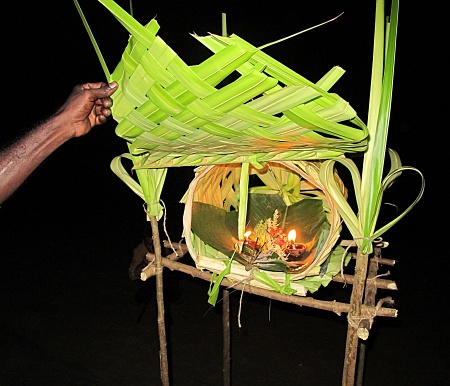
The coconut “house” on the beach dedicated to Kali -
This Pujah/Tovil started at about 9 p.m. The fishermen were standing around in groups and the Pujah specialist and his assistant were singing and accompanying themselves on a small drum. During this period the Pujah man was singing about how Pattini helps people in trouble. As he was singing he was ringing small bells. The whole area was “smoked” with dummala.
He then picked up a gold cloth and attached the thick bracelet with the bells o it. He had been shaking this to accompany the song. (These articles represent Pattini.)
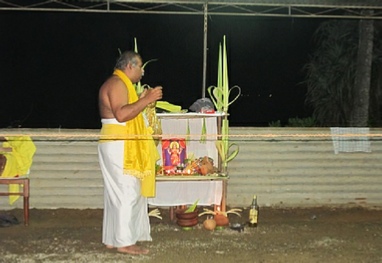

The Assistant was beating a slow beat on a small drum
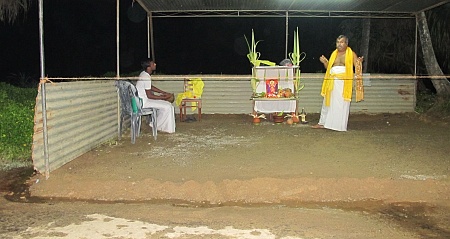

N.B. the bracelets with the bells that he shook in time to the beat of his song about Pattini.

Everyone was given medicated water to drink They put some on their heads and drank from their hands.

Then there was a long tea break during which time everyone was served with plain tea and Lincoln creams! (Everyone had also been served soon after the start of the pujah.)


After this break,the Assistant took over the singing and chanting. The main Pujah specialist was seated to the side, and was fashioning a net like structure
During his songs the Pujah specialist, had two tinkling bracelets of Pattini which he held in his hands and shook during his singing. He took these from behind the “altar”. He also at one point ,took out a golden cloth which he wrapped around himself. The cloth is another symbol of Pattini. N.B. the dividing rope.


Some fishermen were sitting on chairs sharing bulat and drinking arrack.


At midnight the pujah moved to another phase.
During this time the Devils preventing the fishermen from being successful, were being called to the area. They were instructed to accept their offerings and then go away and stop troubling the fishermen. The Pujah men first smoked the “altar” with dummala – this was to call the sea devil who is called Makara. It was Makara who was believed to be preventing the fishermen from being successful and causing them from achieving good catches of fish.
My friend and I happened to be the only occupants of the chairs in front of the altar and so all these songs were therefore directed at us as a result.
“Atora, Aybo Awada” called out the Pujah man and his assistant
(“People in trouble, do not worry, all your problems will go away, Long life, long life” )
(The next morning a large branch was found to have cracked off our “Holy Tree” and fallen to the ground. This was believed to be a sign that had there been any devils on the property they had all departed. For example that same day the house cat who had had an evil spell placed on him by the alleged witches who lived nearby had been released from the spell and came back. In addition there were non stop visitors and phone calls!)


The fishermen built a cooking fire after midnight and whilst some tended this, others prepared coconut milk, dates, rice, honey, beans etc – the constituents of the “Holy” food to be eaten by all in the morning. This was all cooked in an enormous cooking pot.
Whilst the Pattini recitations, drumming and songs were continuing some fishermen were helping to cook in the cooking area. They took it in turns to help cook and then return to share bulat and drink arrack.
The Pujah specialist and his Assistant continued their singing and chanting all through the night until dawn.
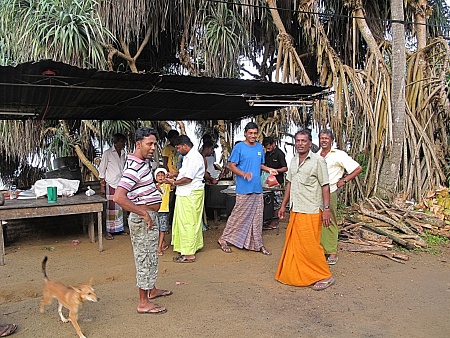
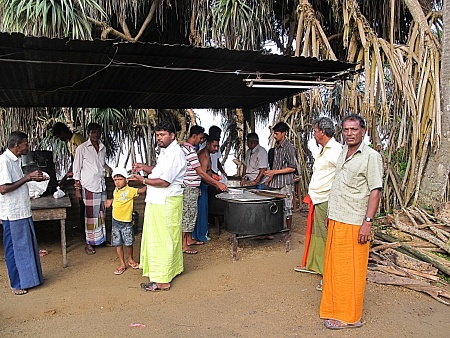
In the morning everyone was given a share of the “Holy food”. Parcels were sent out to the neighbours who lived nearby and other parcels were taken home to share with family members and neighbours who had not attended.




Then the fishermen went swimming. Apparently no one was to go fishing until after midday.

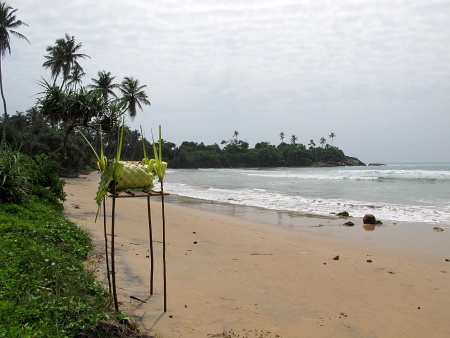
View of Patinni Shrine with the sea behind.
Kali’s shrine


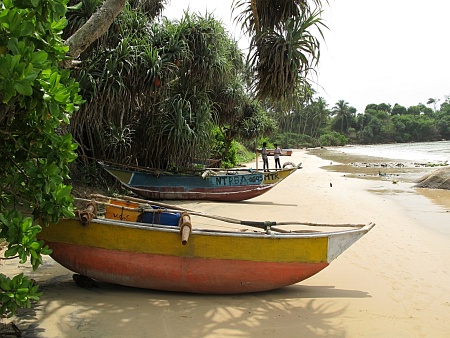
The Fishing Orus (boats) used by these fishermen. Many of the orus carried pictures of Kali inside.
The Head Fisherman said that they would need to have a full scale Tovil if this ceremony was not successful and if their catches did not improve. However fortunately it was successful. The fishermen’s catches improved greatly after this ceremony and no larger and expensive Tovil, which would have included hiring Tovil Dancers, was necessary!
These structures stayed up for the rest of the next day and then the hirers collected the structure. The coconut “houses” were left on the beach until they fell down and disappeared into the sea.
The Pujah specialist and his Assistant took a break in the offering area. This was roped off and no women were allowed to enter. Some other non fishermen were present but there but no women. The non fishermen were people that the fishermen did business with e.g. the wholesale fish trader in his lorry, shop people from the local town etc.

